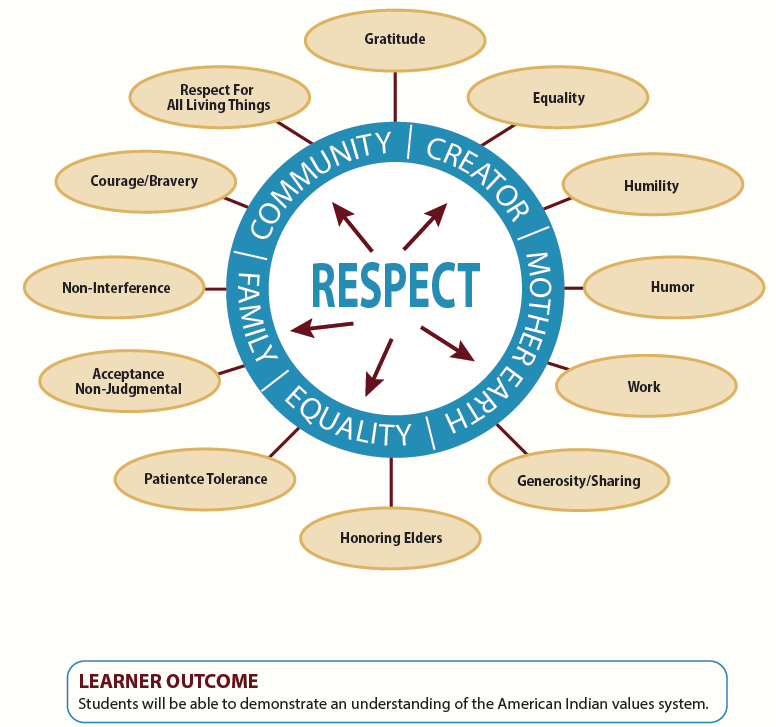Supplement for Hands on Banking Instructor Guides
Elementary School: Unit 2, Section 1 – Needs vs. Wants (p. 22)
Middle School: Unit 1, Section 2 –Value (p. 14)
High School: Topic 1, Lesson 2 – So, What Do You Want? (p. 11)
Lesson Narrative
In many Native families, the focus is on the group, not on the individual. In this lesson, “So, What Do You Want?” it is important to remember Native values of caring for the whole community. Your students may want to include in their “wants” and “needs” the concept of caring for their family.
Preliminary Work:
Share with your students the information below from the Office of Indian Education, Minnesota Department of Education:
American Indians had and continue to have a distinct value system. The center of this system is respect for the Creator, elders, family, community, Mother Earth, and land. Respect is manifested through such behaviors as practicing traditions, learning language, listening, cooperating, honoring elders, non-interference, showing patience and tolerance, acceptance, humor, humility, gratitude, and respect for all living things.
Generosity/Sharing
Generosity and sharing are important parts of the cultural value system of the people. Communities demonstrate this concept through the giveaways that often occur at community powwows. The response of a tribal community during a family crisis such as an accident or death is very generous. Adults continue to share traditional gifts. Hunters share with extended family, elders, and families known to be in need. Other traditional people often share wild rice or maple syrup with extended family members living in urban areas who do not have access to these gifts. Children are taught to share belongings to such an extent that in schools some children share everything they have. American Indian children may think that majority children have been taught in the same way. The value of generosity and sharing ensures the survival of the group. Sharing takes place not only among family members who live together but also among the extended family, which includes many relatives and sometimes the community. Generosity can be seen in the form of money, clothing, food, emotional support, and helping to take care of each other’s children, especially in crisis situations.
Work
American Indians value work and productive activity. A person has the responsibility to provide for one’s family and extended family, to nurture the children, and to contribute to the well-being of the tribe or community. In today’s world those responsibilities are carried out in the workplace in addition to practicing the old ways. The work a person does is valued as a means of carrying out responsibility to family and community, rather than working for the sake of working. A person is valued for being rather than doing. It is important to do one’s share. People at every age level have important work to do. There are no menial jobs; all work is equal, and one should do one’s best.
Give copies of this graphic to your students

Discussion:
In groups, have the students discuss their understanding of generosity and generosity, and teachings from within their culture and how that affects their planning for their future. Give them at least 10-15 minutes for this discussion. Ask for a volunteer to write down what is being said and have another student to be the reporter. At the end of their discussions, the reporter will let the whole class know what was said in their group.
Have a volunteer write the main ideas on the board. After all the groups have reported out, have a class discussion.
Research:
Students will inteerview their families on the following:
- What were the traditional values in their own tribe regarding the care of the family vs. the individual?
- What were the responsibilities of the individual for the community’s welfare?
- How do family members see those values working today in their lives?
- What are the expectations of the elders for the youth regarding caring for family and community?
Presentations:
Have each student report their findings to the class.
Wrap-up Journaling
This journal entry will give the students a chance to reflect on what they have learned about themselves and family in relation to family values on caring for themselves and the family/community.
- Ask students what additional information they would like on the subject.
- Let students know the next topic is “How Money Works” and ask them to come prepared to discuss their ideas on the function of money in their lives.
Sample Narrative Activities:
- Teacher or elder telling a traditional tribal story
- Have students take pictures of items they need or want in their house.
- Amazon wish list vs shopping cart activity
- Tribal hunting and gathering expert call, presentation or video
- Explore career paths in STEM
- Discuss paying for wants and needs
- College scholarship search
- Listen to Native America Calling’s radio show on Indigenous Trade Routes https://www.nativeamericacalling.com/wednesday-march-27-2019-indigenous-trade-routes/
